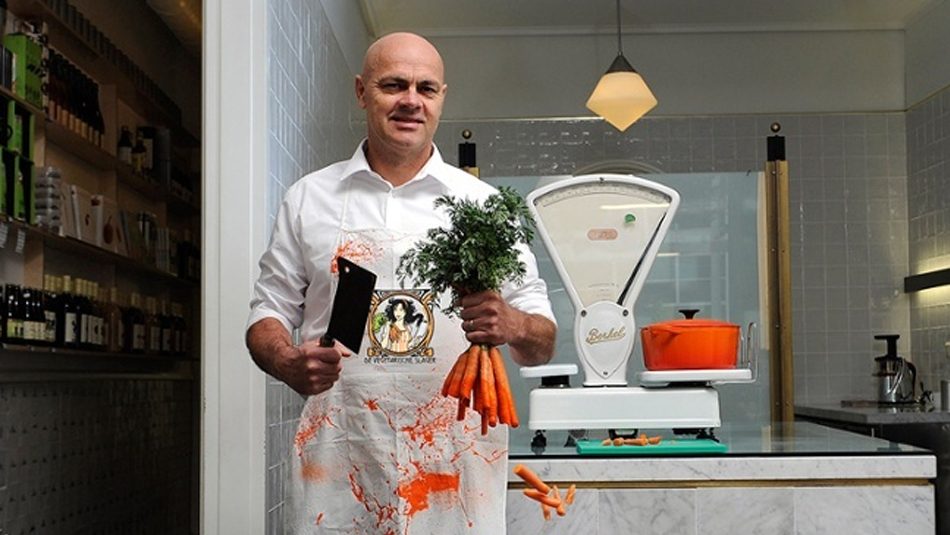
5 Food Crazes To Elevate Your Brand
If you look at the mindset of the current consumer, the food trends make sense. People are more intent on eating food that’s good for them; the concept of “wellness” has emerged as a status symbol. Snacking (a dirty word when I was a child) has turned healthy and hip.
Plus, the evolution of convenience means fast-food doesn’t have to be bad for you. And with the Internet providing a constant real-time window into diverse cultures and happenings abroad, folks are looking for adventure when it comes to their palates and they’re becoming more mindful about their impact on the world. All good things!
So it should come as no surprise that 2017’s food trends include things like purple foods, dosha dining, and alternative pastas. But what does that mean for you, as a food brand marketer or branded produce operation? Well, go with the flow, I like to say. When you see a food craze, you’re looking at an opportunity to present your product in a new way that resonates with consumers right now.
Clear trends make it easier to craft messages that hit those deeply emotional triggers, ultimately inspiring purchases as well as pre- and post-purchase social chatting about your brand. Now, not every trend will align with your brand; but if you keep your finger on the pulse, opportunities will emerge. Let’s look at some examples:
Purple Power
Majestically-colored foods are popping up everywhere: purple long beans, cauliflower, bells, asparagus, corn; elderberries, açaí berries, blackberries, edible lavender; and the list goes on. Purple foods feel adventurous, but the purple power transcends the vibrant color and often indicates nutrient density and antioxidants.
Essentially, the darker the color of a food, the higher the antioxidant content and nutrients, and the healthier the food. In fact, one health and nutrition study found that adults who regularly eat purple fruits and vegetables have a reduced risk of getting high blood pressure and lower HDL cholesterol. They’re also less likely to be overweight.
Actionable insight for food marketers:
Obviously if your branded produce or food product is purple, look closely at the nutritional content and jump on the purple train. Ok so your product may not be purple, but does it go well with a popular purple food? If so, suggest recipes or attractive pairings to go along with it, or think about forming a partnership with a purple food brand.
Plant Butchery
No, we’re not talking about taking a chainsaw to your neighbor’s tree dropping infinite leaves over the fence nor bonsai amateur hour. I mean a new wave of butchers carving up vegetables to show the world the art of plant-based carnivory.
Chefify describes well this trend: “Plant-meat creators use a whole range of different plant proteins to produce dishes that have the look and even the texture of meat. Mushroom, beetroot, peas, yams and wheat are just a few of the ingredients that this new generation of culinary magicians are crafting into incredibly meat-like dishes.”
But plant butchery isn’t intended to be simply a vegetarian option. These chefs will not compromise taste nor texture, and find creative ways to excite and satisfy consumers without resorting to any actual animal meat.
Actionable insight for food marketers:
Plant butchery is cruelty-free, plus many consider a diet richer in plant-based proteins healthier with all the weight loss benefits, and it’s certainly lower in fat. Appeal to the growing number of consumers who value holistic nutrition and environmental stewardship along with artful preparation and maximized deliciousness. Certifications help build trust with consumers. Consider becoming REAL certified.
And the theme continues: bring the adventure!
Dosha Dining

According to the teachings of this Indian holistic practice, humans each have a unique constitution comprised of energies called doshas. By understanding which energies dominate your constitution, you can adapt your diet and lifestyle to achieve balance, since foods also contain energetic qualities.
The Ayurvedic philosophy suggests our bodies are made up of three doshas: vata (wind energy), pitta (fire energy), and kapha (water energy). An Ayurvedic diet is based on six key tastes: sweet, sour, salty, bitter, pungent, and astringent. Each one has a different and energizing effect on the body and mind, and can positively or negatively alter your doshas. For example, fiery individuals should eat foods that are more cooling.
Coupled with yoga to enhance the physical body, Ayurveda is said to be a proverbial fountain of youth—and who doesn’t want to feel younger? Personalized eating (lots of fruit and veggies, but cooked different ways), and meditation plans help mitigate the effects of illness, insomnia, stress, or digestive problems.
Actionable insight for food marketers:
This trend is a win-win in terms of presenting your brand in a new way, whether sponsoring holistic wellness events, crafting ads to appeal to yogis, or producing/sponsoring a podcast or video series showing how to incorporate your products into more mindful food prep. Besides providing a base for content to speak to this consumer (i.e. tell them how they can cook and eat your food according to their dosha; create a bundle of recipes with this theme), the interest in Ayurvedic dining and the number of cultural activities surrounding this trend give you a clear opportunity to partner with influencers to promote your food.
Alternative Pastas

Pasta is making a comeback, but not in the traditional sense. Instead, chefs and manufacturers continue to suggest more nutrient-dense options, including zucchini noodles, quinoa-based spaghetti, and rotelle made from beans and lentils. In fact, nearly any spiralized vegetable can make an appearance in noodle dishes. I like spaghetti squash as a base since it has a natural noodle-like consistency and it’s packed with vitamin A. Bonus: These alternative pastas tend to contain less calories and more protein and fiber than their conventional counterparts.
Actionable insight for food marketers:
Knowing consumers are absolutely open to using vegetables in new ways, branded produce brands have a unique opportunity to market products in innovative ways. If your food aligns with the above, I’d encourage a content marketing strategy heavy in how-to videos, progressive and innovative yet simple recipe catalogs, and content educating eaters about comparative benefits.
Brands might also encourage consumers to enter social media photo contests encouraging users to show how they use your product as a pasta alternative. This marketing opportunity doesn’t stop at supermarket shoppers; there’s a huge opportunity with foodservice as well.
Bowl Meals

From soups and smoothie bowls to the well-known Buddha bowl (a filling mix of greens, raw or roasted veggies and a healthy grain, such as quinoa or brown rice), these handy meals are portion-controlled and easy to tailor to consumers’ personal preferences.
So whether your target market fancies vegetables, rice, noodles or burritos, the idea is to create a bowl emphasizing taste and texture while also sporting a healthy mix of protein and carbohydrates. Bonus: Nutrient-rich ingredients such as açaí berry, pomegranate, avocado, and bok choy make a powerful statement in these meals.
Actionable insight for food marketers:
With so many bowl meal options—and within so many ethnic food arenas—it’s almost impossible not to have a food to market as poke, Buddha, noodle, or açaí friendly. Bingo. There’s your chance for not only recipe suggestions, but themed dinner party ideas, viral contests, entertaining cooking videos, and comprehensive nutritional meal announcements—not to mention a perfect opportunity to partner with a restaurant chain for co-promotion and seasonal partner programs.
Sometimes a food craze appears… crazy. However, if you break down the emotional (or logical) reason behind the consumer lift of said craze, you may very well find an incredible marketing opportunity to elevate your brand. So, keep your eye on cultural trends, go with the flow, tweak your message accordingly, amplify, and reap the delicious rewards.






